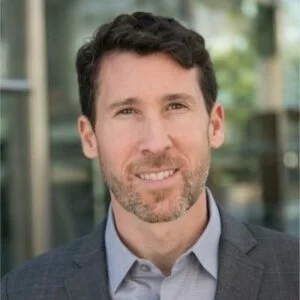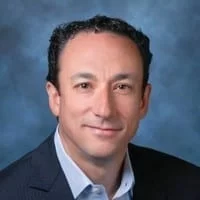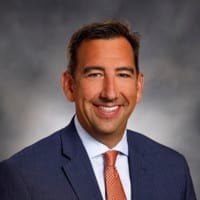
Data can be a revolutionary force in healthcare. But to unlock its full potential, leaders must rethink and rebuild their healthcare data strategy.
Painful truths about the healthcare data landscape were brought into focus by the COVID-19 pandemic. The outbreak also spurred real-time insights into the future of data strategy, which will ideally inform care beyond the pandemic.
“I think the pandemic has spotlighted the importance of data as a way to deliver care,” said Jason Joseph, Chief Digital and Information Officer for Spectrum Health. “I expect that the organizations that see that future will make very strategic investments in advancing digital data technology as a way to drive their business, and not see it as just a cost to manage.”
The experts weigh in on what their health systems learned about data strategy during the pandemic, and what healthcare leaders must keep in mind while they build a framework for the analytics-driven future.

Dr. Dan Riskin, CEO of Verantos
Data cannot make a difference if it is not analyzed and its insights returned to the clinical team. It must be the right data: complete, clean, contextualized and normalized. It must also be wisely stored, secured, organized, and made accessible both for real-time insights and the long-term use of advanced data analytics. Otherwise, it’s just more stuff that the hospital has in storage—and for plenty of health systems, that’s currently the case.
Dan Riskin, Adjunct Professor of Surgery and Biomedical Informatics Research at Stanford and CEO of Verantos, believes that healthcare data and analytics could change medicine and save lives at a scale that rivals penicillin and Pasteur’s germ theory.
“In the 2020s, there are tons of treatments available for most conditions,” Riskin points out. “The question is how are doctors choosing for a patient who has multiple comorbidities when there are multiple treatment options available? They don't have good information.”
According to Riskin, the quantity of data does not substitute for a lack of quality.
"If you're using low quality data, doubling the amount of data or taking it by a hundred X does not give you a different answer. It does not give you a better answer. The key is to use high quality data, whether it's a small amount or a large amount and power it sufficiently for the assertion you're trying to make," he said.
But how does a health system acquire high-validity data to guide their decisions? A study is currently being sponsored by the FDA that explores this very question, Riskin explained. They currently hypothesize that understanding the EHR phenotype and having an accurate depiction of the patient as the starting position.
"Then like we do everything everywhere else in healthcare, check the accuracy, create a sample that has a gold standard and check that you've achieved high accuracy," he said. "This is the step almost no one does, but we do it everywhere else in healthcare is we check to make sure what we did work."
John Brownstein, PhD, is Chief Innovation Officer at Boston Children’s Hospital and a professor at Harvard Medical School. His view of the healthcare data landscape is informed by his background as an epidemiologist. He knows that robust and precise public health data translates to better real-time response for patients—if that data is actually available.
“When the virus hit the shores of the US, we were pretty data blind,” Brownstein said. “We didn't have good surveillance systems around symptoms or cases, we didn't have the diagnostics, and we didn't have understanding.”

John Brownstein, Chief Innovation Officer at Boston Children's
“The pandemic has exposed major data gaps when it comes to pandemics, from the very initial stages to even today,” he added.
From a public health standpoint, that’s far from ideal. He noted that healthcare data conditions improved somewhat as the pandemic continued and information was accumulated. However, he also pointed out that many projects that tracked COVID-19 were volunteer efforts. Johns Hopkins’s respected virus-tracking web tools, for example, are the result of researchers manually scraping local data from countless jurisdictions' online reporting.
Some publicly available health data fails to capture precise demographics points. For example, the geographic spread of a disease does not record race or income, both information that could inform better care. To Brownstein, that raises questions of who should be taking responsibility for defining and organizing data for the community: health systems, the federal government, or a collaboration of the two?
“As much as we like to talk a big game about using data to drive decisions, when it comes to real-time response, I don't think we do a good enough job in that space,” he said.
“A lot is written about how the ‘Holy Grail’ is to move information between organizations,” said Darren Dworkin, former Chief Information Officer at Cedars-Sinai. “With all due respect, when people figure that out, they're going to realize that was just step one.”

Darren Dworkin, CIO at Cedars Sinai
According to Dworkin, this interoperability challenge sets the stage for a bigger prize: distilling data into real-time insights that can inform the course of care. However, getting there will require considerations of how health data is acquired and normalized. Additionally, health systems must examine how their tech tools and applications are selected and deployed.
That starts with the electronic medical record (EMR), which Dworkin referred to as the “table stakes” of healthcare data. Hospitals will have to assess how well their EMR data has been integrated. They will also need to consider whether the countless tools that surround it impede access and sharing.
“The protocols, the decision support, and the layers of content we build out over the years really represent pathways to enabling how we deliver care,” Dworkin said.
Healthcare IT experts, he explained, will eventually find “the secret sauce” that allows for advanced analytics applications. Ideally, these applications would not hinder remote access to health data, but instead contribute to shareable insights across the health system.
There are already plenty of EMR-fed, analytics-driven digital dashboards in place at hospitals across the country, Dworkin explained. But he believes that many physicians and health leaders may not have fully grasped their value prior to the pandemic.
“What I'm really hoping is that executives across the country [saw] that usefulness of dashboards and especially the predictive analytics that are built into these dashboards—and that becomes an elixir that they don't want to let go of," he shared.

Kris Nessa, Enterprise Director of Customer Success at Dell Medical School, University of Texas at Austin
An interconnected, intelligent global health system remains out of reach as long as healthcare data gaps and governance failings remain. But now, health systems and volunteer partnerships are already doing hard work to assemble clean and potent data sets that produce real-time insights.
Kris Nessa, the Enterprise Director of Customer Success at Dell Medical School at The University of Texas at Austin, noted that EMRs have existed for decades. Now, she believes it’s time for health systems to focus beyond a holistic and shareable look at the individual patient.
“Now pivot to how we use it effectively for research algorithms that predict a patient's health. So we can successfully and proactively have a conversation with that patient and show them, ‘If you continue on this trend, here's what it looks like. And here's how we can go together to maybe mitigate some things ahead of time’,” she said. “The data is going to be very powerful in the next five to ten years.”
As the pandemic hit, Spectrum’s Jason Joseph found himself seeking out knowledge gaps within his hospital system.

Jason Joseph, Chief Innovation and Digital Officer at Spectrum Health
“What do we really need to know?” he pondered early on. He and his health system had to tackle several pressing issues:
He sought to answer those questions and develop a better real-time response. Therefore, his team routed needs through specialized internal groups. These groups determined how to acquire and organize the necessary health data. Then, they identified which tools were needed to create insights.
Joseph noted that such agility is key, but it can only work until a team encounters a problem. For example, if a team advances an analytics project, they must be receptive if their technology is not adequate or if ill-defined data is hindering the creation of shareable data tools. The process requires time and resources, but pays off.
One example could be health data points around COVID-19 patients. Teams must examine how even simple inferences must considered. Does that term only apply to those who have recently tested positive and have symptoms? Does it include those with "long COVID"? How about those who no longer have active cases?
According to Joseph, the pandemic demonstrated how important it is to pivot away data strategy as an "obligation." Instead, health systems should embrace it as a fundamental business and care engine.
“In the past we may have still thought of IT as just something we had to do to run the place,” Joseph says. “I think it has been very interesting and enlightening for so many to say ‘No, no it's more than that. This is actually the way we're going to make all of this better’.”
Experts will need to pursue the true potential of health data even after pandemic subsides. They must explore issues around data governance and applicability, Joseph explained.
“All those counting mechanisms—the way we define things— become really important,” Joseph said. “Because if you don't stabilize and understand where you are, how can you predict where you're going to be?”
Joseph explained that going forward, health systems must closely observe data governance and its specificity.

Chris Harper, CIO at Kansas University Health System
Unoptimized health data governance and workflows often prove to be huge drains on staff and major barriers to unlocking analytics' tools capabilities, according to Chris Harper, Chief Information Officer at University of Kansas Health Systems.
Early in his tenure at Kansas, he studied how the disparate internal data landscape was causing operational delays. He said, at the time, the health system employed 60,000 unique access databases. These collectively acted like a “data warehouse”—a situation that was completely unsustainable.
“A typical reporting individual, as requests are coming in, is spending around 30-40% of their time hunting and gathering data. They're trying to normalize that and put it into this access database,” he said, adding that demand was growing by over 10% year-over-year.
“I quickly used the data to show that if we just hire one or two [more people], soon after that we're going to have to hire more and more. But we're going to be running the same process and getting the same value out of it, which is what we're having issues with.”
A health system must understand its technology layer to pivot from data normalization and governance to application. This strategy approach requires considerations of the systems storing the data, the people accessing them, and the technology procurement process.
“Today you can't really split your data analytic strategy from your application strategy,” he said. “We try to make sure we have not only the right technologies, applications, and workflows defined. But also, the data that are going in are coming back out as valuable insights that our clinicians and administrators can act on.”
Systems must align their metrics, sources, and applications, Harper explained. Otherwise, healthcare will “come to a place where our data is really not going to make a lot of sense.”
While the pandemic put healthcare data availability and governance issues on full display, it also provided health systems the opportunity to gather and apply data in real time. At Geisinger Health, Chief Innovation Officer Karen Murphy, PhD, was able to harness the power of well-thought-out data analytics on a systems level.

Karen Murphy, CIO at Geisinger
During the first wave of the pandemic in the spring of 2020, Murphy said Geisinger sought to detect caseload patterns. This allowed them to project hospital capacity. Like many other health systems, Geisinger put a temporary pause on elective surgeries; this diverted the brunt of their staff and resources toward the burgeoning outbreak.
However, a total shutdown of elective procedures was unsustainable. Therefore, the system used insights from the first wave to project where they would need personnel once cases surged again.
“We approached the second wave a little bit differently,” Murphy said. “We relied on the data to predict what we were going to see over the next couple of weeks. Then we really dial down and dial up our elective procedures, without canceling them completely based on bed capacity. That has been tremendously important.”
Geisinger Health also leveraged data to monitor COVID-19 outbreaks among staff. After analysis, data showed that practice and policy changes were necessary to reduce spread among staff.
“We were able to home in by monitoring employee COVID infections and doing contact tracing. We really identified behaviors that we wouldn't have thought of had we not been monitoring the data,” Murphy said. “Behaviors that we needed to adjust so that we lowered that degree of communication while people were at work.”
Murphy said her system used solid data analysis to learn trends, adjust to capacity, and monitor PPE availability. She agreed with other experts that the last 18 months have changed how she views health data strategy.
“We've learned the importance of data to drive decision making. The advantages of predictive analytics and other digital strategies have really enhanced our ability to respond,” she said.